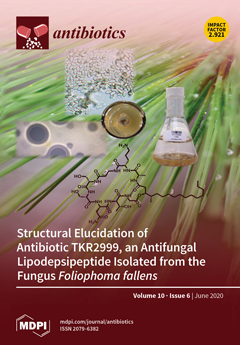The rapid emergence of drug-resistant strains and novel viruses have motivated the search for new anti-infectious agents. In this study, the chemical compositions and cytotoxicity, as well as the antibacterial, antifungal, antitrichomonas, and antiviral activities of essential oils from the leaves, rhizomes, and
[...] Read more.
The rapid emergence of drug-resistant strains and novel viruses have motivated the search for new anti-infectious agents. In this study, the chemical compositions and cytotoxicity, as well as the antibacterial, antifungal, antitrichomonas, and antiviral activities of essential oils from the leaves, rhizomes, and whole plant of
Hornstedtia bella were investigated. The GC/MS analysis showed that β-pinene,
E-β-caryophyllene, and α-humulene were found at high concentrations in the essential oils. The essential oils exhibited (i) inhibition against
Staphylococcus aureus, methicillin-resistant
Staphylococcus aureus,
Staphylococcus epidermidis with minimum inhibitory concentrations (MIC) and minimum lethal concentration (MLC) values from 1 to 4% (
v/v); (ii) MIC and MLC values from 2 to 16% (
v/v) in
Candida tropicalis and
Candida parapsilosis; (iii) MIC and MLC values from 4 to 16% in
Enterococcus faecalis; and (iv) MIC and MLC values from 8 to greater than or equal to 16% (
v/v) in the remaining strains, including
Escherichia coli,
Pseudomonas aeruginosa,
Klebsiella pneumoniae,
Candida albicans, and
Candida glabrata. In antitrichomonas activity, the leaves and whole-plant oils of
Hornstedtia bella possessed IC
50, IC
90, and MLC values of 0.008%, 0.016%, and 0.03% (
v/v), respectively, whilst those of rhizomes oil had in turn, 0.004%, 0.008%, and 0.016% (
v/v).Besides, the leaf oil showed a weak cytotoxicity against Vero 76 and MRC-5; meanwhile, rhizomes and whole-plant oils did not exert any toxic effects on cell monolayers. Finally, these oils were not active against EV-A71.
Full article






